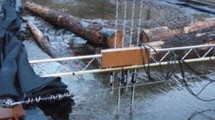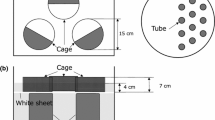Abstract
Rheotaxis is a widespread behavior with many potential benefits for fish and other aquatic animals, yet the sensory basis of rheotaxis under different fluvial conditions is still poorly understood. Here, we examine the role that vision and the lateral line play in the rheotactic behavior of a stream-dwelling species (Mexican tetra, Astyanax mexicanus) under both rectilinear and turbulent flow conditions. Turbulence lowered the flow speed at which threshold levels of rheotactic performance were elicited, an effect that was independent of sensory condition. Compared to fish with access to visual information, fish without access exhibited cross-stream casting behaviors and a decrease in the accuracy with which they oriented upstream. Visual deprivation effects were independent of availability of lateral line information and whether flow was rectilinear or turbulent. Fish deprived of lateral line information exhibited no measureable deficits under any of the conditions of this study. This study indicates that rheotactic abilities persist in the absence of both vision and lateral line under both turbulent and non-turbulent conditions, but that turbulence enhances either the motivation or ability of fish to orient to slow currents.











Similar content being viewed by others
Abbreviations
- LL:
-
Lateral line
- PRI:
-
Positive rheotactic index
- RA:
-
Rheotactic accuracy
- TGS:
-
Turbulence-generating structure
- V:
-
Vision
References
Arnold G (1969) The reactions of the plaice (Pleuronectus platessa L.) to water currents. J Exp Biol 51:681–697
Arnold GP (1974) Rheotropism in fishes. Biol Rev Camb Philos Soc 49(4):515–576
Bak-Coleman J, Coombs S (2014) Sedentary behavior as a factor in determining lateral line contributions to rheotaxis. J Exp Biol 217:2338–2347
Bak-Coleman J, Court A, Paley DA, Coombs S (2013) The spatiotemporal dynamics of rheotactic behavior depends on flow speed and available sensory information. J Exp Biol 216:4011–4024
Baker CF, Montgomery JC (1999a) Lateral line mediated rheotaxis in the Antarctic fish Pagothenia borchgrevinki. Polar Biol 21:305–309
Baker CF, Montgomery JC (1999b) The sensory basis of rheotaxis in the blind mexican cavefish, (Asytanax fasciatus). J Comp Physiol A 184:519–527
Chachereau Y, Chanson H (2011) Free-surface fluctuations and turbulence in hydraulic jumps. Exp Therm Fluid Sci 35:896–909
Chagnaud BP, Bleckmann H, Engelmann J (2006) Neural responses of goldfish lateral line afferents to vortex motions. J Exp Biol 209:327–342
Cotel A, Webb P, Tritico H (2006) Do brown trout choose locations with reduced turbulence? Trans Am Fish Soc 135:610–619
Crowder DW, Diplas P (2002) Vorticity and circulation: spatial metrics for evaluating flow complexity in stream habitats. Can J Fish Aquatic Sci 59:633–645
Dijkgraaf S (1963) The functioning and significance of the lateral-line organs. Biol Rev 38:51–105
Gardiner JM, Atema J (2007) Sharks need the lateral line to locate odor sources: rheotaxis and eddy chemotaxis. J Exp Biol 210:1925–1934
Karlsen HE, Sand O (1987) Selective and reversible blocking of the lateral line in freshwater fish. J Exp Biol 133:249–262
Kollaus KA, Bonner TH (2012) Habitat associations of a semi-arid fish community in a karst spring-fed stream. J Arid Environ 76:72–79
Kozlowski C, Voigt R, Moore P (2003) Changes in odour intermittency influence the success and search behaviour during orientation in the crayfish (Orconectes rusticus). Mar Freshwater Behav Physiol 36:97–110
Kulpa M, Coombs S (2015) The lateral line is necessary for blind cavefish rheotaxis in non-uniform flow. J Exp Biol: 1–10. doi:10.1242/jeb.119537
Lacey R, Neary VS, Liao JC, Enders EC, Tritico HM (2012) The IPOS framework: linking fish swimming performance in altered flows from laboratory experiments to rivers. River Res Applic 28(4):429–443
Leavy TR, Bonner TH (2009) Relationships among swimming ability, current velocity association, and morphology for freshwater lotic fishes. N Amer J Fish Manage 29:72–83
Liao JC (2007) A review of fish swimming mechanics and behaviour in altered flows. Phil Trans Roy Soc B: Biol Sci 362:1973–1993
Liao JC, Cotel A (2012) Effects of turbulence on fish swimming in aquaculture. In: Palstra AP, Planas JP (eds) Swimming physiology of fish. Springer, Berlin, pp 109–127
Liao JC, Beal DN, Lauder GV, Triantafyllou MS (2003) The Kármán gait: novel body kinematics of rainbow trout swimming in a vortex street. J Exp Biol 206:1059–1073
Lyon EP (1904) On rheotropism. I. Rheotropism in fishes. Amer J Physiol 12:149–161
Mathewson RF, Hodgson ES (1972) Klinotaxis and rheotaxis in orientation of sharks toward chemical stimuli. Comp Biochem Physiol A 42:79–84
Matsuura S, Ikeda K, Furukawa T (1971) Effects of streptomycin, kanamycin, quinine, and other drugs on the microphonic potentials of goldfish sacculus. Jap J Physiol 21:579–590
McFarland W, Levin SA (2001) Modeling the effects of current prey acquisition in planktivorous fishes. Mar Fresh Behav Physiol 35:69–85
Meyers JR, Macdonald RB, Duggan A, Lenzi D, Standaert DG, Corwin JT, Corey DP (2003) Lighting up the senses: FM1-43 loading of sensory cells through nonselective ion channels. J Neurosci 23:4054–4064
Mitchell RW, Russell WH, Elliot WR (1977) Mexican eyeless characin fishes, genus Astyanax: Environment, distribution and evolution. Spec Publ Mus Texas Tech Univ 12:1–89
Montgomery JC, Baker CF, Carton AG (1997) The lateral line can mediate rheotaxis in fish. Nature 389:960–963
Murzyn F, Chanson H (2009) Free-surface fluctuations in hydraulic jumps: experimental observations. Exp Therm Fluid Sci 33:1055–1064
Olszewski J, Haehnel M, Taguchi M, Liao JC (2012) Zebrafish larvae exhibit rheotaxis and can escape a continuous suction source using their lateral line. PLoS One 7:e3666
Partridge BL, Pitcher TJ (1980) The sensory basis of fish schools: relative roles of the lateral line and vision. J Comp Physiol A 135:315–325
Pavlov DS, Tyuryukov SN (1993) The role of lateral-line organs and equilibrium in the behavior and orientation of the dace, Leuciscus leuciscus, in a turbulent flow. J Ichthyol 33:45–55
Pavlov DS, Lupandin DS, Skorobogatov MA (2000) The effects of flow turbulence on the behavior and distribution of fish. J Ichthyol 40:S232–S261
Pitcher TJ, Partridge BL, Wardle CS (1976) A blind fish can school. Science 194(4268):963–965
Pohlmann K, Atema J, Breithaupt T (2004) The importance of the lateral line in nocturnal predation of piscivorous catfish. J Exp Biol 207:2971–2978
Przybilla A, Kunze S, Rudert A, Bleckmann H, Brücker C (2010) Entraining in trout: a behavioural and hydrodynamic analysis. J Exp Biol 213:2976–2986
Smith DL (2003) The shear flow environment of juvenile salmonids. (Unpublished PhD Dissertation). University of Idaho, Moscow, Idaho
Suli A, Watson GM, Rubel EW, Raible DW (2012) Rheotaxis in larval zebrafish is mediated by lateral line mechanosensory hair cells. PLoS One 7(2):e29727
Tritico HM, Cotel AJ (2010) The effects of turbulent eddies on the stability and critical swimming speed of creek chub (Semotilus atromaculatus). J Exp Biol 213:2284–2293
Van Trump WJ, McHenry MJ (2013) The lateral line system is not necessary for rheotaxis in the Mexican blind cavefish (Astyanax fasciatus). Integ Comp Biol 53:799–809
Van Trump WJ, Coombs S, Duncan K, McHenry MJ (2010) Gentamicin is ototoxic to all hair cells in the fish lateral line system. Hear Res 261:42–50
Vogel S, LaBarbera M (1978) Simple flow tanks for research and teaching. Bioscience 28:638–643
Webb PW, Cotel AJ, Meadows LA (2010) Waves and eddies: effects on fish behavior and habitat distribution. In: Domenici P, Kapoor BG (eds) Fish locomotion: an eco-ethological perspective. Science Publishers, Enfield, pp 1–39
Acknowledgments
The authors would like to thank Timothy Bonner for supplying the Mexican tetra, Steve Queen for the construction of the flow tank, Nancy Boudreau and Joe Bak-Coleman for assistance with the statistical analyses and one anonymous reviewer for raising the important issue of turbulence scale and the IPOS framework for studies on turbulence. This work was supported by the Office of Naval Research [award N00014-12-1-0375] to S.C. All applicable international, national, and/or institutional guidelines for the care and use of animals were followed.
Author information
Authors and Affiliations
Corresponding author
Rights and permissions
About this article
Cite this article
Elder, J., Coombs, S. The influence of turbulence on the sensory basis of rheotaxis. J Comp Physiol A 201, 667–680 (2015). https://doi.org/10.1007/s00359-015-1014-7
Received:
Revised:
Accepted:
Published:
Issue Date:
DOI: https://doi.org/10.1007/s00359-015-1014-7




